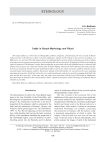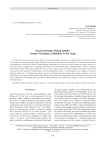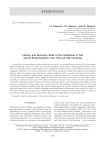Ethnology. Рубрика в журнале - Archaeology, Ethnology & Anthropology of Eurasia
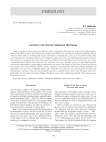
Corvids in the Buryat Traditional Worldview
Статья научная
Using a structural-semiotic approach together with a comparative historical one, and based on ethnographic, lexical, and folklore sources, this study focuses on the raven and the crow as characters in Buryat mythology. Buryat terms for these birds are of Mongolian origin. Folk beliefs concerning the raven are more elaborate than those concerning the crow. The image of the raven is ambiguous, whereas the crow is an unambiguously negative character. The analysis of vocabulary and of the minor genres of folklore shows that Buryats paid attention to the various zoological features of these birds: plumage color and voice in the crow; plumage color, size, beak, flight duration, collectivism, emotionality in expressing joy and greed in the raven. The essence of both birds of prey was believed to be impure. The raven symbolized heaven, spring, vigilance, war, masculinity, and rancor. Being intelligent and independent, the raven was the Buddhist deity’s aide. Unlike the crow, the raven was patronized by evil spirits and other demonic characters. The crow was a feminine character, a symbol of sky, winter, water, bloodlust, and rumor. Both birds were associated with shape-shifting. The Buryat views, then, combined specifically ethnic and universal ideas about corvids.
Бесплатно
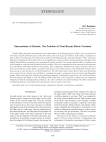
Descendants of eleudei: the problem of oirat-buryat ethnic contacts
Статья
Eleuths (Ölöts) played an important part in the ethnic history of the Mongol peoples of Inner Asia, in particular of the Oirats, being the dominant group of the Oirat union at the early stages of its history. In this study, an attempt was made to fi ll in one of the gaps in the ethnic history of the Turko-Mongol peoples, using the ethnonym “Ölöt”. The major limitation in studying the Oirat ethnic history is the insuffi ciency of sources. Much can be gained from using Buryat and Sakha (Yakut) folklore, specifi cally epics, genealogical legends, and tales. The reason is that the Ölöts, according to one of the hypotheses, took part in the formation of those peoples. This idea is supported by the reconstruction of protoforms of certain Buryat and Yakut ethnonyms and eponyms. Their comparative and historical analysis indicates ethnic ties between the Buryats and the Yakuts, and their participation in the ethnic history of the Mongolian stratum. These facts open up a wider perspective on Turko-Mongol ties. The Ölöt ethnic history shows them to have been distributed across vast territories of Inner Asia and Siberia, eventually becoming a component of various Turkic and Mongolian groups, while preserving their identity and featuring prominently in ethnogonic legends not only of Dörben-Oirats, but of the Buryats and Yakuts as well. The fi ndings of this study attest to the complexity of ethnic processes among the Mongolian and Turkic speaking nomads of Eurasia. Also, they contribute to the understanding of the ethnic composition of Mongolia, Buryatia, and Yakutia, thus widening the scope of studies on the Altai.
Бесплатно
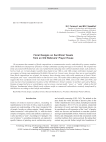
Floral designs on sacrificial towels from an old believers' Prayer house
Статья
We reconstruct the semantics of fl oral compositions on commemorative towels, embroidered by women, members of the Old Believers Bespopovtsy (priestless worship community rejecting marriage) in Novosibirsk. The original vine motif, associated with the funerary cult, was transformed by replacing vines with more familiar motifs, such as fl owers, berries, buds, etc. Certain designs resemble those found in late 19th to early 20th century embroidery manuals and on wrappers of cheap soap manufactured by Rallet, Brocard, etc. In most cases, however, there are no exact parallels. Some fl oral compositions are original: for instance, those showing vases with scrolls reminiscent of Jesus Christ’s monogram, and “vases” turned into letters on Our Savior’s icons. The results of the technological and stylistic analyses suggest that most sacrifi cial towels were made in the late 1800s and early 1900s, some in the 1940s and 1950s, and some may have been manufactured in places of the Old Believers’ former residence in northern and central Russia. Designs arranged in friezes or central fi gures, such as crosses, cruciate motifs, “vases”, or “vaults”, allude to the Old Believers’ fundamental values. Ritual towels evidence motifs on commercial embroideries creatively transformed by Old Believers according to their beliefs and traditions.
Бесплатно
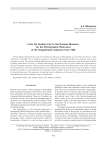
Статья
Serbian fi gured gingerbreads owned by the Russian Museum of Ethnography are described, the history of the collection is provided, and its cultural meaning is evaluated. Ethnographic parallels are analyzed, and archaic examples are cited. The custom of baking gingerbread results from the commercialization of the agricultural tradition of baking ritual bread. In terms of cultural anthropology, the question may be raised whether the replacement of destroyed originals by plaster replicas preserves the information potential and ethnographic value of the collection. Its interpretation is relevant to national identity in new Balkan nations such as Slovenia, Croatia, and Serbia. Another problem is if and how a craft shared by several peoples can be an ethnic marker. In terms of ethnographic museology in the globalizing world, the prospects of acquiring recent collections are discussed. The role of such collections in constructing new national identities may be considerable.
Бесплатно
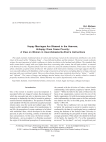
Статья научная
This study examines traditional ideas of women and marriage, based on the instructions attributed to one of the rulers of the epoch of the “Religious Kings”—Usun-Debeskertu-Khan, and his ministers. The focus is made on female virtues, the most important of which is adherence to duties in relation to the husband and children. The standards that noble women had to comply with were higher than those concerning other women, but still quite realistic, as attested to by historical records. Negative female traits were said to be caused by untamed emotions, which cause one to forget about commonly accepted norms of behavior. The analysis of the instructions relating to marriage suggests that they were especially influenced by Buddhism, which, using various forms of instruction, including didactic writings, endowed marriage with a new, spiritual content. There were three forms of marriage, tentatively described as “divine”, “earthly”, and “infernal”. The causes of happy and unhappy marital unions were believed to be mainly related to women’s properties mentioned in the instructions. Marital harmony was said to depend mostly on the woman.
Бесплатно
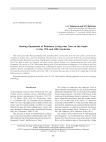
Hunting equipment of Russians living near Tara on the Irtysh in the 17th and 18th centuries
Статья
This article describes Russian hunting tools unearthed from several sites near the town of Tara on the Irtysh: Ananyino I, Izyuk I, Tara, and Fort Bergamak. The functions of tools are assessed on the basis of archaeological parallels from the Baraba forest-steppe, ethnographic examples relating to the culture of the Irtysh natives, materials from Fort Albazin and Fort Sayansk, and much earlier burials dating to the Xianbei-Rouran time in the Altai Mountains. The variety of 17th–18th century hunting tools is best represented at Mangazeya, Fort Alazeya, and Fort Stadukhin. Apart from typological comparisons, technological analysis was carried out for several wooden and metal artifacts. Results are helpful for revealing continuities between the 17th–18th century Russian hunting tradition at Tara and that practiced in Old Rus and in the 15th–17th century Russian state, as well as for comparing it with the Siberian native traditions.
Бесплатно
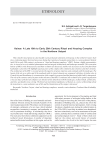
Kainar: a late 18th to early 20th century ritual and housing complex in the Northern Ustyurt
Статья
Бесплатно
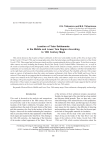
Location of Tatar settlements in the Middle and Lower Tara region according to 18th century maps
Статья
Тhis article discusses the location of Tatar settlements in the lower and middle reaches of the Tara on maps of the Tarsky Uyezd (1784 and 1798) and on topographic plan of the Kartashevskago and Bergamotskaya districts of the Tarsky Uyezd (1798). These maps had not been previously used for reconstructing the history of the region. To test their accuracy, other sources are used, including the Inventory Book of the Tarsky Uyezd, Gerhard Miller’s itineraries, etc., as well as the results of archaeological and ethnographic studies. Based on the analysis of maps, patterns in the locations of Tatar settlements are reconstructed. They were situated between the mouth of Tara and its confl uence with the Chertalinka River on the right bank, and between the Chertalinka and Kalinka rivers on the left bank. The reliability of the late 18th century maps as sources of information about the winter and summer settlements of the Tatars of the Middle and Lower Tara is assessed. These maps do not suggest that the settlements were still seasonal rather than permanent at that time. The winter camps were situated on the Tara high terrace, away from the valley, and summer camps were on the fl ood plain, close to the villages. The general pattern was that people settled along the river, often close to the places where the Tara tributaries fl owed into it. Place names are suggestive of seasonal settlements. Comparison with modern maps suggests that the current settlements pattern on the Lower and Middle Tara emerged in the late 18th century.
Бесплатно
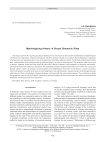
Mythologizing history in Buryat Shamanic rites
Статья научная
This study explores the regional specificity of Buryat rites with regard to the variable manifestation of mythological and historical components, and late innovations. The first attempt is made to reconstruct the mythological component of spoken texts accompanying these rites in the historical and ethno-cultural context. On the basis of field and archival data, contamination and transformation of myth and history in ritual is demonstrated. The principal characters such as deities, shamans, tribal and clan chiefs are described, and the semantics and pragmatics of ancestor and master- spirits in the historical context are discussed. The mythological status of supernatural characters of the rite is assessed. Specific ethnic criteria of turning real personalities into mythological characters in the historic context are listed. Universal features traceable in the process of turning history into myth include a regular mixture of mythological motifs with historical facts, interchange of temporal planes, and especially the reincarnation theme. The conclusion is made that pragmatic rites are the most stable, whereas the general tendency is that rites become less and less connected with mythology and progressively less hyperbolic.
Бесплатно
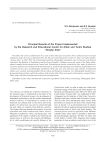
Статья научная
We outline the result of collaboration by a team of more than sixty researchers from 22 Russian and 13 foreign institutions under the project implemented by the Research and Educational Center for Altaic and Turkic Studies “Greater Altai” in 2022–2023. Six archaeological and four ethnographic expeditions were carried out in the Russian Federation, the Republic of Kazakhstan, and the Kyrgyz Republic. Findings concern the origin of the Turkic ethno-cultural complex and its spread across Central Asia. Archaeological surveys revealed new sites, many of which were excavated, and some were included in the museum projects. Extensive photographic and volumetric documentation was conducted. In the course of ethnographic expeditions, Turkic epic texts were collected, many elements of traditional culture were revealed, showing parallels between Altaic and Kyrgyzian traditions. Also ethnographic parallels were documented between Slavic and Turkic cultures of the Greater Altai. These were used to elaborate the concept of Slavo-Turkic unity, which has both theoretical and practical implications.
Бесплатно
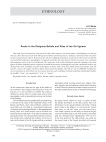
Rocks in the religious beliefs and rites of the Ob Ugrians
Статья научная
This study, based on materials collected in the 18th–20th centuries, and on the author’s field findings over the last 40 years, shows the role of rocks in the Ob Ugrian worldview and ritual practices. Evidence is provided on the veneration of various natural stone objects. Reasons for the cult of worshipping such places are discussed. One reason was that the rock resembled a human or animal figure. In legends and myths, the stone houses of heroic ancestors were correlated with numerous caves in the Ural Mountains. The main part of the article introduces materials relating to the stone figures of deities and patron spirits, supported by mythical narratives explaining the ways that a mythological hero was changed into stone. Examples are given of the figures of deities with a stone base found among local groups of the Ob Ugrians, such as the Lyapin and Sosva Mansi, Synya and Polui Khanty. The role of rocks in childbirth and funerary rites is examined, as well as their role in economic practices such as fishing. In Khanty and Mansi mythological beliefs, the modifier «stony» was equivalent to «iron» or «strong».
Бесплатно
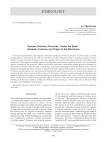
Russian Orthodox churches “under the bells”: semantic features and origin of the worldview
Статья научная
The religious foundations underlying the construction of Russian Orthodox churches “under the bells”, and the meaning and role of this notion, are analyzed with reference to the traditional worldview. Architectural features of such churches are described. They belong to a rare type, and have been constructed in Russia from the 14th century to the present time. Their multiple meanings, influenced by Byzantine and European traditions, related to the key Orthodox notions, are analyzed. The most basic of these was the idea of the ladder, symbolizing spiritual growth, as evidenced by dedication of churches “under the bells” to the Stylites, to preachers developing key Orthodox notions, and to converts engaged in spiritual maturation, as well as to miracles believed to influence human life in a profound way. Dedications to miracles and miraculous icons, associated with military glory, and to canonized warriors, patrons of the military, are based on the idea of the victorious and life-giving cross. The image of the bell as a divine messenger is embodied in the tradition of placing bells right above the liturgical space, making perception of the “voice of God” by the flock more direct. A conclusion is reached that the pillar-like edifices of churches “under the bells” represent the most meaningful elements of the Russian worldview, marking the Orthodox cultural landscape, whose central idea is that of spiritual maturation and triumphant Christian faith.
Бесплатно
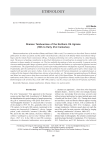
Shaman tambourines of the northern Ob Ugrians (18th to early 21st centuries)
Статья научная
Shaman tambourines of the northern Khanty and Mansi (18th to early 21st centuries) are described. Sources include publications by other specialists and the author's fi eld materials collected in the Khanty-Mansi Autonomous Okrug–Yugra and the Yamal-Nenets Autonomous Okrug. A shaman performing rites with a tambourine is called koipyng-nyait. The process of making a tambourine is described. Information on 44 tambourines is summarized in a table with reference to shape, number of resonators, etc. The few available descriptions of rites are provided. A separate section concerns anthropomorphic images of patron spirits, carved on handles and beaters or represented as figurines inserted in tambourines. The Lyapin Mansi practiced a custom of providing tambourines with figurines of guards, koipyng-pupyg. Traditionally, after the tambourine's owner had died, the tambourine became a family patron spirit, whose image was supplied with specially sewn men's clothes. In my view, the northern Ob Ugrian shamanism was underdeveloped, as evidenced by the shaman's limited functions, absence of special attire, etc. The shamanic paraphernalia used by Khanty and Mansi are much scarcer than those associated with the cult of Mir-Susne-Khum. The main distribution areas of tambourines in the 20th to early 21st centuries are the basins of the Lyapin River (Mansi) and the Synya River (Khanty). Both belonged to the territory that, in the 18th–19th centuries, was the contact zone between Ob Ugrians and Nenets.
Бесплатно
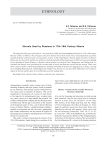
Shovels used by Russians in 17th-18th century Siberia
Статья
The study describes types of the shovel—one of the most widely used and multifunctional tools in 17th–18th century Russian culture of Siberia. The principal collection includes more than twenty intact and fragmented specimens unearthed during 13 fi eld seasons of excavations at Tara, in the Omsk Region. Shovels found elsewhere in Western Siberia are also described, and the role of this tool in the households of Russian pioneers in Siberia is assessed. Judging by the drawings in Semen Remezov’s chronicle and excavation records from Tara, Mangazeya, and Nadym forts, we conclude that shovels were specialized for various kinds of work, and that they varied with the season. There were diverse types used for constructing fortifi cations, dwellings and utility structures, for digging graves, tillage, clearing snow, handling bulk materials, and baking bread; children’s toy shovels are also described. Information is provided on shapes of shovels and the types of wood Siberians used for making them.
Бесплатно
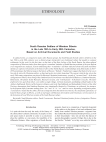
Статья научная
In cultural terms, as compared to many other Russian groups, the South Russian (Kursk) settlers of Siberia in the late 19th to early 20th centuries were a distinct group, having their own traditional culture but usually no compact settlements. In this work, for the first time, on the basis of the State Archive of the Kursk Region, the ethno-cultural composition of Siberian settlers from that region is examined. Attitudes of South Russian peasants of the post-Reform era to migration are analyzed, reasons underlying their “wanderlust” and their reflection about relocation and ethnic identity are explored. Documents at the State Archive of the Tomsk Region, and the findings of my fi eld studies in 2014– 2018 pertaining to the Siberian stage in the history of Russian “Yuzhaks” (Southerners) suggest that their priority was to live side by side with Ukrainian settlers, as they had used to do in their homeland. The reason is that the key role in the early 20th century migrations was played by Russian-Ukrainian frontiersmen—people of “no man’s land”. At the time of migration to Siberia, those living in the southern Kursk Governorate were Russian Old Believers, Southern Russians, Belarusians, Ukrainians (Little Russians), Russian Cossacks, and “Cherkassians” (Ukrainian Cossacks). The latter preferred to live apart from others, even within a single village. Archival documents and findings of field studies in the Anzhero-Sudzhensky District of the Kemerovo Region, and in the Topchikhinsky and Kulundinsky Districts of the Altai Territory demonstrate that Southern Russians were situationally identical to Ukrainians, as evidenced, for instance, by the frequent shift of surname endings from “-ko” and “-k” to “-ov” and vice versa, depending on migration plans. A conclusion is made that the ethnic diversity of migrants from the Kursk Governorate, the situational equivalence of Eastern Slavic groups in Siberia, as well as marriages with Russian old residents and Ukrainians, were key factors in the formation of local Siberian variants of the South Russian culture.
Бесплатно
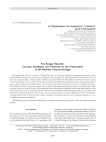
Статья научная
This study deals with the concept of «cultural heritage» in the Kyrgyz Republic, including both material culture and traditional ideology. We describe their codification, and strategies for their preservation and popularization. We draw on a large database, which includes findings of original fieldwork. We outline the elaboration of the concept of cultural heritage and its content, presenting a systematic description of institutional aspect and meaning, and we analyze the practices of its implementation. The historical and cultural heritage is viewed as a multifactorial space. The realities of modern Kyrgyzstan suggest that the nation implements integration strategies in foreign policy. While using the notions of cultural heritage and traditional values, the republic strengthens its ties with other members of the CIS, raising the level of its integration into the Central Asian community and maintaining its status as part of the world civilization. Cultural heritage is a key resource of social change and the economic stabilization of local communities. Its preservation at the level of everyday culture, academic, and educational practices, museums, festivals, etc. is a condition of national consolidation.
Бесплатно
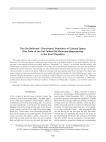
Статья научная
This study addresses the structure of cemeteries and types of tombstones in the funerary tradition of the Russian Priestless Old Believers (known as Bespopovtsy) living in the Ust-Tsilma District of the Komi Republic. For the first time, a description of their graveyards, known as “mogilniki”, or “mogily”, is provided, and their history and preservation are outlined. Traditional beliefs concerning cemeteries and their arrangement are cited. The symbolism of the forms of tomb structures, reproducing not only canonical prescriptions and requirements, but also certain pre-Christian beliefs, is analyzed in detail. Folk terms relating to the dead and the afterlife are included. The degree and nature of post-revolutionary transformations, profoundly affecting the foundations of the Old Believers’culture, are explored. Despite the attempts to preserve traditions, modern lifestyles took root in the 1960s and 1970s. Elements of local specificity in funerary rites have nonetheless survived and can be seen in the symbolism of tombstones, synthesizing Christian and pre-Christian traditions. Findings of ethnographic, linguistic, and archival studies are presented.
Бесплатно

